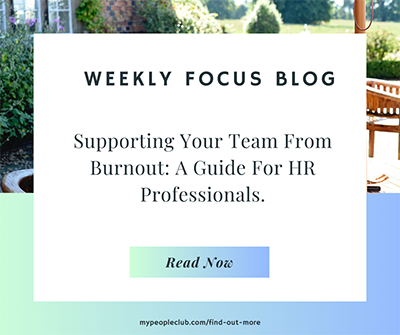An Agile Approach to Cultivating Workplace Wellbeing
This week is World Wellbeing Week, I do love these awareness weeks, they act as a great reminder for us all to stop and review how we do things, personal and professionally. Especially as HR folk, we’re often busy focussing on others that we pop ourselves at the bottom end of the priority list!
I was thinking about what to focus on this week, as wellbeing is a huge topic, and no matter how much I delved into the ideas flurrying my mind, I kept on coming back to one thing that’s been on everyone’s minds lately: burnout. It is topping all the surveys as the major contributor to our wellbeing being affected.
If there’s one thing, we know in HR it’s how demanding and fast-paced the workplace can be, and burnout is becoming all too common. And that’s what I’m here to talk about in this blog, I’ll share some insights and practical tips on how you can support you and your employees and create a culture of wellbeing that best reflects your brand.
Firstly, we need to recognise the signs of burnout. You know the feeling: exhaustion, cynicism, decreased productivity, maybe feeling a bit more emotional about things, and that overall sense of running on empty.
By understanding these symptoms, it will allow you to become much more proactive at identifying these signs early on, in yourself as well as those around you. This will give you the chance to put the measures in place to prevent it taking hold.
One important step is to encourage work-life integration or blend if you will. If the last few years have taught us anything it that we’ve come to realise that work-life balance is a bit of a myth for a lot of people. Instead, let’s focus on finding that sweet spot where work and personal life coexist harmoniously. The go to here is things like considering offers of flexible start and finish times, remote work options, and promoting regular breaks throughout the day. It’s all about finding that balance that works for everyone, and yes that includes you too! You cannot fill from an empty cup.
Do you prioritise health and wellbeing in your workplace?
It’s a simple question and one you may answer ‘yes’, but what are you doing to keep it a priority on your list when things or life get in the way? There is no one size fits all and you need to really consider what fits the culture you’re trying to create.
Here’s some of my top tips: Think about implementing wellness programs, providing access to mental health resources, and promoting activities like yoga, meditation, or mindfulness practices. When you prioritise wellbeing, you create an environment where self-care is valued and encouraged. Often this is created from the top down, so again you need to practice what you preach! We all go off tangent sometimes – even I do and Ilive and breathe this stuff!
Some of the contradictions I’ve seen – there’s no point promoting wellbeing and then emailing your team at 10pm at night (and expecting responses!), or not having any holidays/switching off time yourself – you have to be the good example to others.
Ultimately, something like Wellbeing is not just about policies and programs; it’s about fostering open communication. Creating a safe space where all employees feel comfortable discussing their challenges and seeking support where needed. For me, this is where holding regular check-ins, where you really listen to what your team has to say will gain you valuable insights and allow you to be able to address burnout more effectively.
And it’s not just about understanding how employees feel in that moment, by letting employees have a say in their work processes, encouraging open communication in a safe environment, and empowering them to make decisions that benefit their wellbeing helps to create an environment that values growth and positive change.
And remember, leading by example is key. As an HR professional, I really can’t stress this enough, take care of yourself and prioritise your own wellbeing. When your team sees you practicing self-care and setting boundaries, it sends a powerful message that taking care of oneself is not just acceptable but essential.
Like I touched upon earlier, these culture shifts tend to implement quicker when it comes top down so, offering resources and training to support your team will really help. Providing access to things like stress management workshops, resilience-building sessions, and mindfulness training, will equip managers and leaders with the tools they need to identify and address burnout effectively. By investing in your team’s growth and wellbeing, you’re empowering them to take proactive steps towards their own wellness.
Creating a culture of wellbeing takes time and effort, there’s no overnight success here, but trust me it’s absolutely worth it.
What is the one thing you will try this week to encourage a happier and healthier workplace?
PS: If you need a helping hand, our membership platform has support for things such as resilience masterclasses, live sessions on mindfulness, wellbeing and workplace happiness. If you’re feeling burnt out yourself, our community is there to champion you on, offer support and some much-needed fun. We also have our trusted partners like Tracey Turton, Calm at work, Narelle Summers (link these) and others who can help you with burnout issues
Find out how we can help you here

